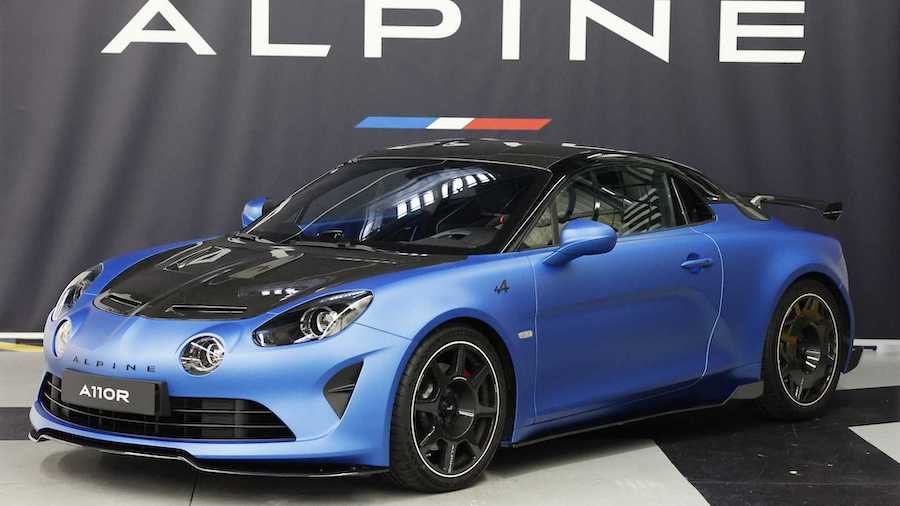Hardcore Alpine A110 R is stiffer, lighter track car

Alpine has crowned the Alpine A110 line-up with a stripped-back, hardcore variant with weight and performance figures that would usually be the preserve of lightweight, open-wheel track-day cars.
Called the A110 R – for ‘radical’ – it has been devised as a no-compromise, circuit-oriented plaything heavily inspired by Alpine’s involvement in motorsport.
Sitting above the entry-level A110, mid-rung GT and stiffened S (and thus likely to be priced above £70,000), the R will complete the core A110 family when it goes on sale later this month. However, bosses have not disclosed whether further variants could arrive before the sports car goes electric in 2026.
With hot laps at the top of its agenda, it weighs just 1082kg – down 34kg on the “already very light” A110 S and lighter, even, than the latest iteration of the 2.0-litre Mazda MX-5.
Mass has been shed chiefly by the fitment of lighter bucket seats, the removal of noise insulation from the engine bay, the swapping of the glass rear panel for an aluminium item and the use of carbon fibre for the bonnet, wheels and new-shape rear ‘window’ panel.
But it’s the enhanced focus on dynamic agility that marks the R out most obviously from its stablemates. In consultation with Alpine’s Formula 1 engineers at Enstone, the team at Les Ulis has created a much more purposeful aero package, while overhauling the chassis for maximum stiffness and response.
The new swan-neck spoiler, rear diffuser, flat undercarriage, flat front wheel-face designs and reshaped side skirts combine to boost downforce (by up to 29kg at top speed over the A110 S) and reduce drag (by 5% in Track mode) for both a higher top speed and greater stability in corners.
It’s also 10mm lower than the A110 S as standard, and the hydraulically adjustable Sachs dampers give a further 10mm drop for the “ultimate on-track experience”. Alpine has also increased the spring stiffness at each end by 10%, the front anti-roll bar by 10% and the rear one by 25%, as well as fitting semi-slick Michelin PS Cup 2 rubber claimed to boost cornering grip by 15% while improving on-track durability.
Stopping power comes from beefier, 320mm composite discs from Brembo on each corner, for which Alpine designed bespoke cooling scoops behind the front bumper to ensure consistent performance under load.
Drivetrain changes are comparatively subtle. The R uses the same 296bhp turbo 1.8-litre four-pot engine and seven-speed wet-clutch automatic gearbox as the S, although the exhaust has been tweaked to give “a roar that is readily recognisable as a sound signature worthy of the Alpine name”.
The aero and weight modifications add up to tangible performance gains. Alpine claims a 0-62mph time of 3.9sec – 0.3sec quicker than the S – and a 177mph top speed.
The package is rounded off by a new bespoke matt blue paint option that matches the Alpine F1 car’s colour, while the carbon fibre roof panel is left exposed. Inside, liberal use of microfibre, six-point racing harnesses and pull straps instead of door handles mark this out as a track-focused car.
A Q&A with the A110's programme director, Xavier Sommer
Is this the last combustion-powered A110? “I can’t answer this, but I think the A110 R we’re presenting is clearly a very nice version to complete the present line-up. The A110 is the ‘entrance gate’, the GT is for the motorway, the S brings sportiness on the road and – critically – on track, and the R is our ‘radical’ version.”
Will the R’s emphasis on aero and weight efficiency help when it comes to developing EVs? “It was made independently. As soon as we are developing new things and we optimise the efficiency in aerodynamics, I think it will be profitable for all, but the main objective at this moment was to improve the A110’s aerodynamics. As soon as we increase our expertise, it will benefit all the other versions we have after.”
How did you benchmark a car with no direct rivals? “It was always the case with the A110: a unique object. The idea was not to lie in front of everyone, but to propose something that’s more radical in our own way.”
So why no extra power? “Because the power ‘arms race’ is not our objective. It is not our DNA. I think today we have sufficient power. What our customers now expect is us to continue to improve the lightness, the aerodynamics and the chassis behaviour, and I’m sure it [the A110 R] will answer that expectation.”
Related News
